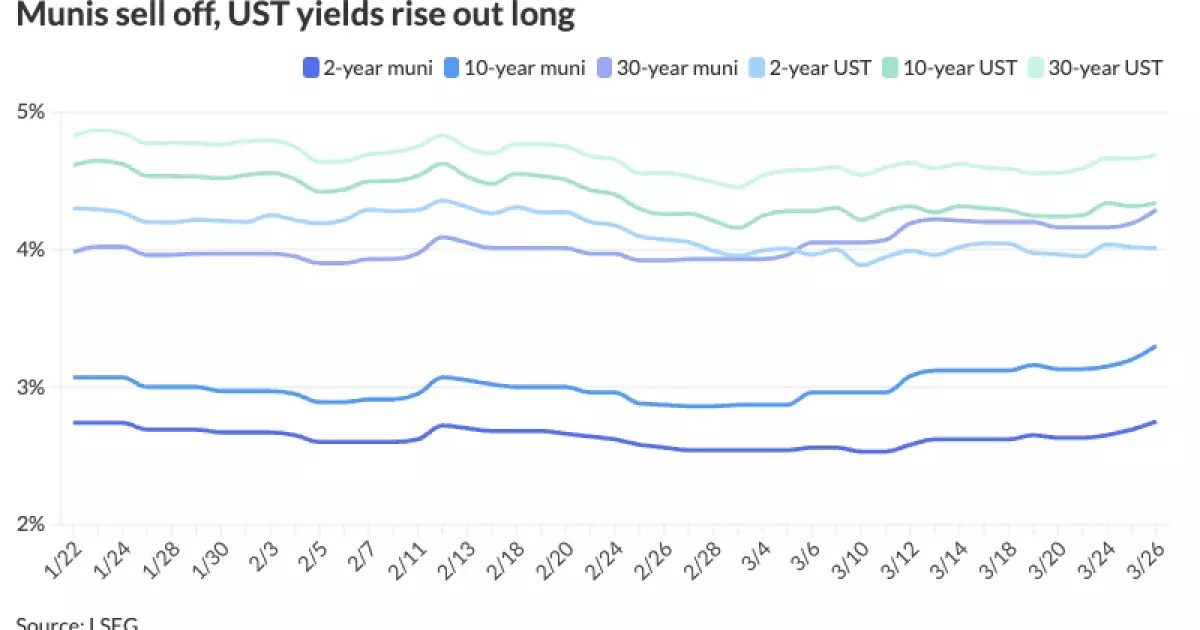As we witness the municipal bond market’s recent turmoil—with yields experiencing double-digit cuts for the second time this month—it becomes essential to analyze the driving forces behind this financial retrenchment. The adjustment of municipal yields by up to 12 basis points, juxtaposed with an uptick in U.S. Treasury yields, points to a complex and, frankly, distressing macroeconomic backdrop. Investors and analysts alike are not merely spectators; they are participants navigating a sea of uncertainty, with their strategies being disproportionately affected by a myriad of factors.
In a landscape marked by volatility, we can see how the selling pressure is not just a statistical anomaly. The Municipal Market Data (MMD) readings reveal a troubled demand landscape, exacerbated by liquidity strains. The time is ripe for scrutiny—an honest assessment reveals that this market is at a psychological tipping point.
Analyzing Recent Trends
On the surface, the numbers tell a disconcerting tale. The Investment Company Institute reported a modest inflow of $19 million for the week ending March 19. This figure seems paltry, especially when contrasted against previous weeks boasting inflows exceeding $376 million. Financial markets thrive on momentum, but with outflows reported at $216.4 million by LSEG, one can’t help but feel a sentiment of unease creeping into the marketplace. Exchange-traded funds are not immune, bucking the trend slightly with their $306 million inflow, but these fluctuations offer little reassurance in a broader market characterized by risk aversion.
What remains uncertain is whether these dynamics are temporary or indicative of a structural change. The sentiment on Wall Street reflects a cautious approach; after all, the transition from a bullish to a bearish market isn’t typically a linear journey but a winding trail filled with bumps and pitfalls. As James Pruskowski of 16Rock Asset Management pointedly observes, “liquidity is as strained as it has been in a long time,” leading us to question whether current conditions are merely a prelude to a more extensive correction.
The Role of Macroeconomic Factors
The interplay of tariffs, tax proposals, and evolving economic data creates a quagmire of uncertainties that policymakers are ill-equipped to address. The discourse surrounding economic tariffs, for example, invokes fears about inflation and stunted growth. Insert DOGE cuts—cryptocurrency dynamics that can skew traditional financing—and it becomes crystal clear that we are in choppy waters. Traders need not only to brace for the repercussions of fiscal maneuvers but also for the oscillating sentiments of the crypto market.
There is a palpable call for caution in the air, and as Ron Banaszek, SVP at Blaylock Van, succinctly summarized, the market is showing signs of “the bigger picture of the buyside and secondary traders” engaging in casino-style gambling rather than prudent investment strategies. This tumultuous environment breeds trepidation, leading to increased risk premiums and widening credit spreads.
Investor Sentiment and Market Dynamics
Amidst confusion lies opportunity, albeit hard to see through the haze of current struggles. The widening Municipal to UST ratios may suggest panic, yet there’s an underlying signal of long-term potential for those willing to embrace calculated risks. As the market seeks a catalyst to ignite renewed interest, investors must wear a dual hat—both as sceptics and as visionaries. The harsh truth is that the market’s reaction is often disproportionate, driven by collective fear rather than inherent economic fundamentals.
Current valuations are compelling, but given the broader context, one must question whether this environment will evoke characteristically weak performance from even sought-after names, such as the New York City Transitional Finance Authority’s notably large $2 billion deal. The very presence of cash in the market does not negate the inherent challenges of drawing in investor interest when competing with existing portfolios.
Looking Ahead
As the primary market prepares for weathering its own storm—with the Department of Airports of Los Angeles planning a colossal $1.534 billion deal—eyes will remain fixed on global economic indicators. Each financial maneuver should be met with analytical scrutiny rather than superficial optimism. As this market paradox unfolds, one key question persists: will cautious patience yield opportunity, or will fear sabotage any fertile ground for recovery?
Prepare for turbulence, as the financial world seems poised on the cusp of a significant shift. Analyzing trends will illuminate various pathways, but the crux of the matter lies in making shrewd choices amidst the cloud of uncertainty that hangs over the municipal bond market today.


Leave a Reply